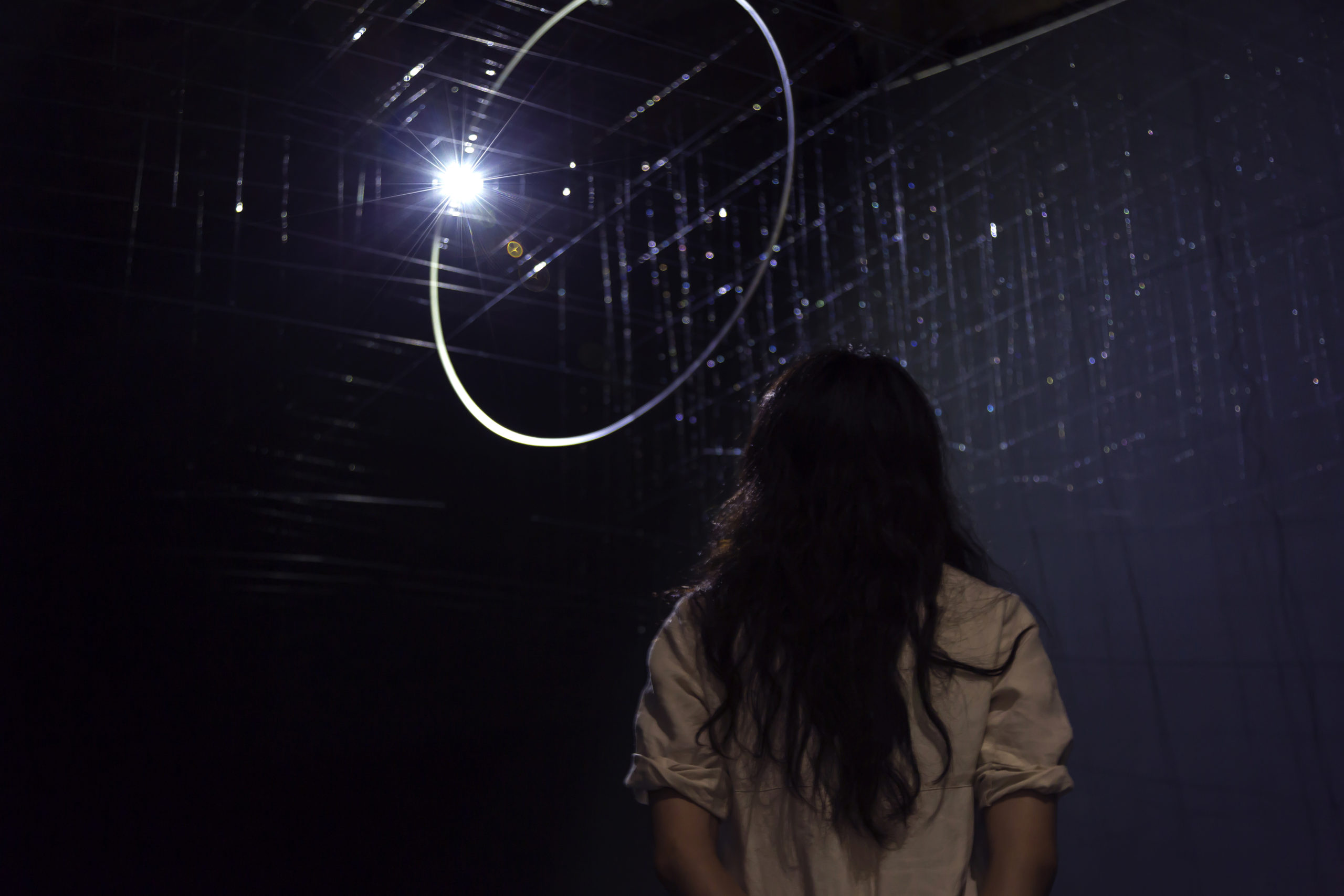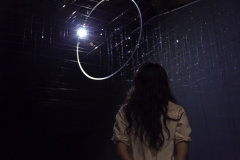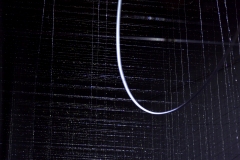Photo: Yohei Yamakami
Shiga Kogen Roman Museum/Nagano, Japan
2015
Nylon thread, Mirror thread, Aluminum, LED, Motor
W:8m D:8m H:7m
Although this work seems to recreate the universe or the movements of the celestial bodies at first glance, it is not a representation of anything. For humans, what is the greatest experience? This is what this work aims to be. The search for such a possibility is related to the act of exploring the limits of human perception. By doing fieldwork pertaining to mountains, caves, or architectural spaces, I research the influence that space and time, and light and darkness, exerts on somatic sensation. In this work, by taking my point of reference from such experiences, space is constructed by whittling its elements down to an absolute minimum. The fact that this ends up resembling an image of the universe suggests that a macro perspective on the universe is akin to a viewpoint from which all concrete phenomena have been purged.
The creator expends almost all his effort on erasing the traces of his handiwork, so that it is only the image that is transmitted — as if it had always existed. If you draw closer and scrutinize it more carefully, you might discover the trace of a hand. Is this not somewhat similar to the perspective of someone who gazes at a distant star, and imagines that there might be life there?
This work may also bear a resemblance to the universe in the sense that it expresses nothing. By “universe,” I am not referring to the space that exists above the atmosphere, but a “natural” existence that is what it is. Nature does not express anything, nor does it demand anything. As such, it unconditionally accepts all human intervention. As a human being, I would like to create something that is close to nature.
Is there any meaning to the human act of creating a virtual nature? When the creator demonstrates his ability as a part of nature (※1), the audience finds something of that nature in the creator: we are moved to have come into contact with part of the universe.
※1 The materials that make up a human body were born inside a star
【“Eye on the Cosmos: Collaborations between Art and Astrology” (2015, Shiga Kogen Roman Museum), from a comment in the catalogue】<D.W>
この作品は一見、宇宙や天体の動きを再現したかのようですが、何かを表わしている訳ではありません。人にとって最大の体験は何か。それが作品の目指すものです。そしてそれは人間の知覚の可能性を探ることに繋がっています。
空間と光と時間が体性感覚に与える影響に関して、山岳や洞窟、建築などの空間に関するフィールドワークを行い、その体験を基に要素を極限まで削ぎ落とし、作品は構成されています。それが宇宙のイメージに似るということは、宇宙を見るマクロ的視は、具体的な事象を削ぎ落としたものだと言えるのではないでしょうか。
作り手は制作の過程において、時に殆ど全ての労力を手仕事の痕跡を消すことに費やします。感覚のみを伝えるために、またはそれがもとからあったかのように見せるために。近づいて良く目を凝らせば、そこに何らかの痕跡が見つかるかもしれません。それは遠い星を眺め、そこに存在する生命を想像することと、どこか似てはいないでしょうか。
何も表わしていない点において、この作品は宇宙と似ていると言えるかもしれません。ここ で言う宇宙とは、大気圏の上の空間のことではなく、自ら然る存在 – 自然を指します。自然は何も表さないがゆえに、何も求めないがゆえに、人の介入を無条件に許します。私は人でありながら自然に近いものを作りたいと考えています。人が自然の在り様を模倣することには意味があるでしょうか。人がその内部にある、自然の一部としての存在を発揮するとき、人はその人の内部に宇宙に触れたときのような感動をみるのではないでしょうか。
※1、人体を構成する材料は星の内部で生まれた。
【「宇宙をみる眼 -アートと天文学のコラボレーション」展(2015,志賀高原ロマン美術館)展覧会図録コメントより】



